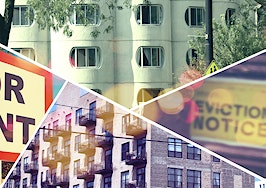A new report shows that rent growth across the U.S. slowed down last month as the coronavirus pandemic ground the economy to a halt.
The report, from RentCafe, shows that the average national rent increased in March by 2.9 percent. However, that increase represents a “hard drop” from the 3.2 percent rise that rents experienced in February, the report explains.
The numbers also represent the first time since 2016 that rents have decelerated between February and March, which according to the report is significant because March is “when the rental season is supposed to kick off.” In total, the report adds, “75 percent of the nation’s renter mega-hubs saw slower yearly rent increases in March compared to February.”
“Under normal circumstances, interest for apartments goes up this time of year, and rent prices would be expected to pick up speed in March,” the report states. “But as more and more states urge social distancing, both landlords and residents have begun seeing the effects of the pandemic.”
And it’s possible these trends may continue in the coming months.
“The data has yet to reflect the full impact of COVID-19,” Doug Ressler, a manager at data firm Yardi Matrix is quoted as saying in the report. Ressler also said that “we expect the impact of coronavirus to last three to six months, before a steady recovery boosts the economy once again.”
The report also shows that year-over-year changes in rent last month varied considerably from place to place. Rents in New York City’s Queens borough, for example, grew 10.1 percent in March, while in Phoenix they grew 9.2 percent.
Other cities that saw strong growth in rent included Seattle, Nashville, and Charlotte, North Carolina.

Credit: RentCafe
On the other hand, March rents only grew 0.6 percent in Los Angeles and 0.9 percent in San Francisco year-over-year. Detroit, Houston and Boston also were among the metro areas with the slowest growth.
The report — which is based on data from the 260 largest cities in the U.S. — ultimately concludes that “rent growth weakened in most of the nation’s renter hotspots.”
RentCafe’s report comes as the pandemic has thrown rental markets across the U.S. into chaos. In an effort to contain the virus, officials have instituted lockdowns, forced businesses to close and advised people to avoid in-person contact. But the consequence of such mandates is that an array of workers — including many in the real estate industry — have seen their income reduced or eliminated altogether.
Jobless claims have spiked as a result, and many landlords are left wrestling with how to respond to tenants who simply don’t have money for rent. Numerous states have also rolled out eviction moratoriums. For the time being, however, the full extent of the crisis’ impact on rents remains to be seen.
Additional resources:
Check out Inman’s state-by-state guide to evictions and rent here. Read the full RentCafe report here.













